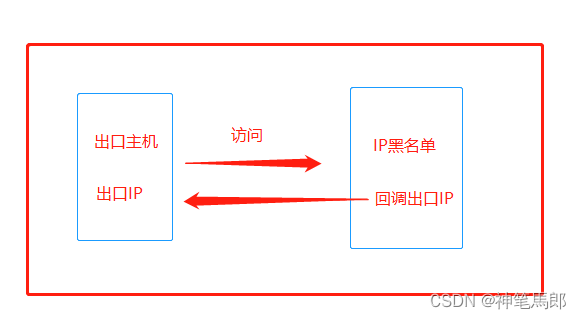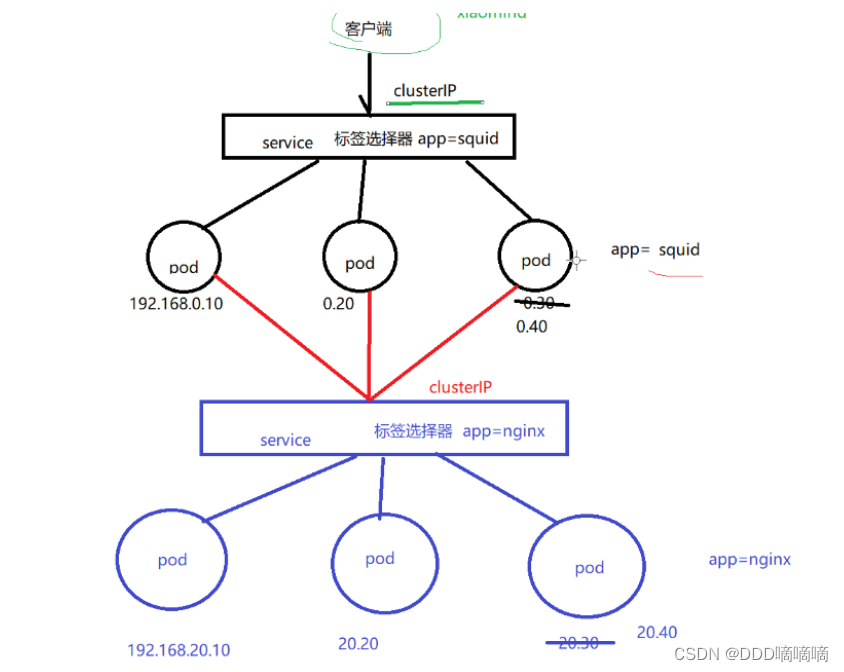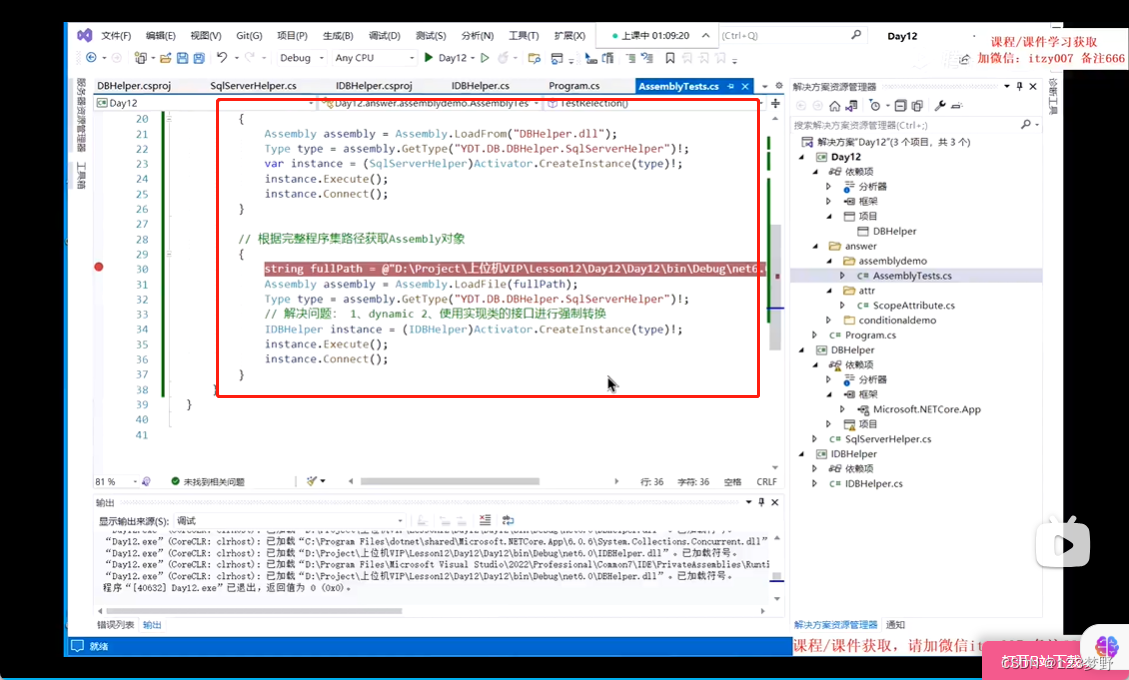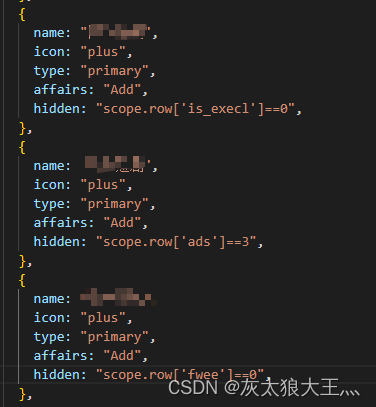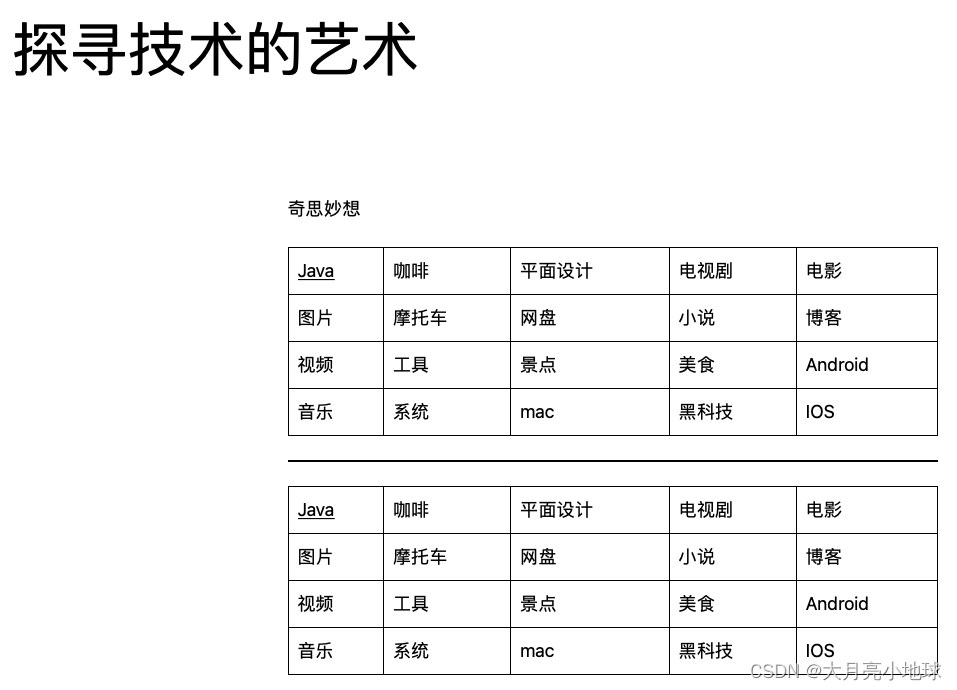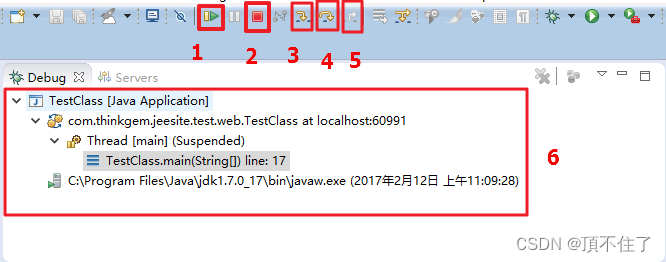十五、面向切面编程AOP
IoC使软件组件松耦合。AOP让你能够捕捉系统中经常使用的功能,把它转化成组件。
AOP(Aspect Oriented Programming):面向切面编程,面向方面编程。(AOP是一种编程技术)
AOP是对OOP的补充延伸。
AOP底层使用的就是动态代理来实现的。
Spring的AOP使用的动态代理是:JDK动态代理 + CGLIB动态代理技术。Spring在这两种动态代理中灵活切换,如果是代理接口,会默认使用JDK动态代理,如果要代理某个类,这个类没有实现接口,就会切换使用CGLIB。当然,你也可以强制通过一些配置让Spring只使用CGLIB。
15.1 AOP介绍
一般一个系统当中都会有一些系统服务,例如:日志、事务管理、安全等。这些系统服务被称为:交叉业务
这些交叉业务几乎是通用的,不管你是做银行账户转账,还是删除用户数据。日志、事务管理、安全,这些都是需要做的。
如果在每一个业务处理过程当中,都掺杂这些交叉业务代码进去的话,存在两方面问题:
- 第一:交叉业务代码在多个业务流程中反复出现,显然这个交叉业务代码没有得到复用。并且修改这些交叉业务代码的话,需要修改多处。
- 第二:程序员无法专注核心业务代码的编写,在编写核心业务代码的同时还需要处理这些交叉业务。
使用AOP可以很轻松的解决以上问题。
请看下图,可以帮助你快速理解AOP的思想:
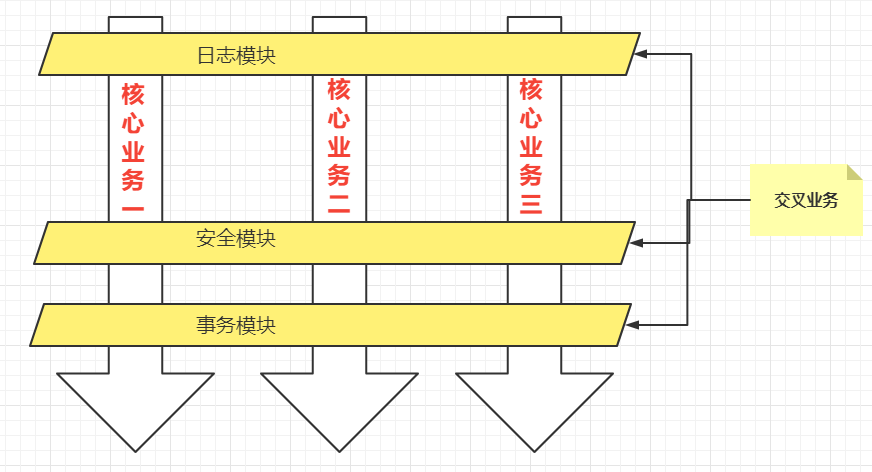
总结
用一句话总结AOP:将与核心业务无关的代码独立的抽取出来,形成一个独立的组件,然后以横向交叉的方式应用到业务流程当中的过程被称为AOP。
AOP的优点:
- 第一:代码复用性增强。
- 第二:代码易维护。
- 第三:使开发者更关注业务逻辑。
15.2 AOP的七大术语
public class UserService{
public void do1(){
System.out.println("do 1");
}
public void do2(){
System.out.println("do 2");
}
public void do3(){
System.out.println("do 3");
}
public void do4(){
System.out.println("do 4");
}
public void do5(){
System.out.println("do 5");
}
// 核心业务方法
public void service(){
do1();
do2();
do3();
do5();
}
}- 连接点 Joinpoint
-
- 在程序的整个执行流程中,可以织入切面的位置。方法的执行前后,异常抛出之后等位置。
- 切点 Pointcut
-
- 在程序执行流程中,真正织入切面的方法。(一个切点对应多个连接点)
- 通知 Advice
-
- 通知又叫增强,就是具体你要织入的代码。
- 通知包括:
-
-
- 前置通知
- 后置通知
- 环绕通知
- 异常通知
- 最终通知
-
- 切面 Aspect
-
- 切点 + 通知就是切面。
- 织入 Weaving
-
- 把通知应用到目标对象上的过程。
- 代理对象 Proxy
-
- 一个目标对象被织入通知后产生的新对象。
- 目标对象 Target
-
- 被织入通知的对象。
通过下图,大家可以很好的理解AOP的相关术语:
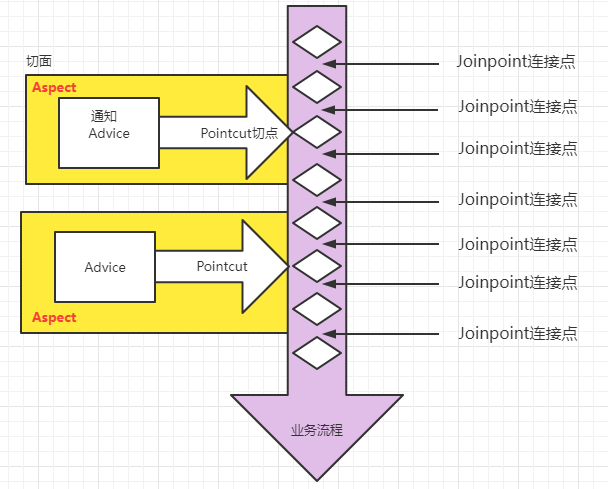
15.3 切点表达式
切点表达式用来定义通知(Advice)往哪些方法上切入。
切入点表达式语法格式:
execution([访问控制权限修饰符] 返回值类型 [全限定类名]方法名(形式参数列表) [异常])访问控制权限修饰符:
- 可选项。
- 没写,就是4个权限都包括。
- 写public就表示只包括公开的方法。
返回值类型:
- 必填项。
- * 表示返回值类型任意。
全限定类名:
- 可选项。
- 两个点“..”代表当前包以及子包下的所有类。
- 省略时表示所有的类。
方法名:
- 必填项。
- *表示所有方法。
- set*表示所有的set方法。
形式参数列表:
- 必填项
- () 表示没有参数的方法
- (..) 参数类型和个数随意的方法
- (*) 只有一个参数的方法
- (*, String) 第一个参数类型随意,第二个参数是String的。
异常:
- 可选项。
- 省略时表示任意异常类型。
理解以下的切点表达式:
- service包下所有的类中以delete开始的所有方法
execution(public * com.powernode.mall.service.*.delete*(..))- mall包下所有的类的所有的方法
execution(* com.powernode.mall..*(..))- 所有类的所有方法
execution(* *(..))15.4 使用Spring的AOP
Spring对AOP的实现包括以下3种方式:
- 第一种方式:Spring框架结合AspectJ框架实现的AOP,基于注解方式。
- 第二种方式:Spring框架结合AspectJ框架实现的AOP,基于XML方式。
- 第三种方式:Spring框架自己实现的AOP,基于XML配置方式。
实际开发中,都是Spring+AspectJ来实现AOP。所以我们重点学习第一种和第二种方式。
什么是AspectJ?(Eclipse组织的一个支持AOP的框架。AspectJ框架是独立于Spring框架之外的一个框架,Spring框架用了AspectJ)
AspectJ项目起源于帕洛阿尔托(Palo Alto)研究中心(缩写为PARC)。该中心由Xerox集团资助,Gregor Kiczales领导,从1997年开始致力于AspectJ的开发,1998年第一次发布给外部用户,2001年发布1.0 release。为了推动AspectJ技术和社团的发展,PARC在2003年3月正式将AspectJ项目移交给了Eclipse组织,因为AspectJ的发展和受关注程度大大超出了PARC的预期,他们已经无力继续维持它的发展。
15.4.1 准备工作
使用Spring+AspectJ的AOP需要引入的依赖如下:
- pom.xml
<!--spring context依赖-->
<dependency>
<groupId>org.springframework</groupId>
<artifactId>spring-context</artifactId>
<version>6.0.0-M2</version>
</dependency>
<!--spring aop依赖-->
<dependency>
<groupId>org.springframework</groupId>
<artifactId>spring-aop</artifactId>
<version>6.0.0-M2</version>
</dependency>
<!--spring aspects依赖-->
<dependency>
<groupId>org.springframework</groupId>
<artifactId>spring-aspects</artifactId>
<version>6.0.0-M2</version>
</dependency>Spring配置文件中添加context命名空间和aop命名空间
- spring-aspectj-aop-annotation.xml
<?xml version="1.0" encoding="UTF-8"?>
<beans xmlns="http://www.springframework.org/schema/beans"
xmlns:xsi="http://www.w3.org/2001/XMLSchema-instance"
xmlns:context="http://www.springframework.org/schema/context"
xmlns:aop="http://www.springframework.org/schema/aop"
xsi:schemaLocation="http://www.springframework.org/schema/beans http://www.springframework.org/schema/beans/spring-beans.xsd
http://www.springframework.org/schema/context http://www.springframework.org/schema/context/spring-context.xsd
http://www.springframework.org/schema/aop http://www.springframework.org/schema/aop/spring-aop.xsd">
</beans>15.4.1.1Spring AOP 基于注解之实现步骤
spring.xml
<?xml version="1.0" encoding="UTF-8"?>
<beans xmlns="http://www.springframework.org/schema/beans"
xmlns:xsi="http://www.w3.org/2001/XMLSchema-instance"
xmlns:context="http://www.springframework.org/schema/context"
xmlns:aop="http://www.springframework.org/schema/aop"
xsi:schemaLocation="http://www.springframework.org/schema/beans http://www.springframework.org/schema/beans/spring-beans.xsd
http://www.springframework.org/schema/context http://www.springframework.org/schema/context/spring-context.xsd
http://www.springframework.org/schema/aop http://www.springframework.org/schema/aop/spring-aop.xsd">
<!--组件扫描-->
<context:component-scan base-package="com.dong.service"/>
<!--开启aspectj 自动代理-->
<!--spring容器在扫描类的时候,查看该类上是否有@Aspect 注解,如果有,则给这个类生成代理对象-->
<!--
proxy-target-class="true" 表示强制使用CGLIB动态代理
proxy-target-class="false" 这是默认值,表示接口使用JDK动态代理,反之,使用CGLIB动态代理
-->
<aop:aspectj-autoproxy proxy-target-class="true"/>
</beans>UserService.java
package com.dong.service;
import org.springframework.stereotype.Service;
@Service("userService")
public class UserService { //目标类
public void login(){ //目标方法
System.out.println("系统正在验证登录。。。。。。");
}
}
LogAspect.java
package com.dong.service;
import org.aspectj.lang.annotation.Aspect;
import org.aspectj.lang.annotation.Before;
import org.springframework.stereotype.Component;
@Component("logAspect")
@Aspect //切面类是需要使用@Aspect 注解进行标注的
public class LogAspect { //切面
//切面= 通知 + 切点
//通知就是增强,就是具体的要编写的增强代码
//这里通知Advice以方法的形式出现。(因为方法中可以写代码)
// @Before注解标注的方法就是一个前置通知
@Before("execution(* com.dong.service.UserService.*(..))")
public void 增强(){
System.out.println("这是一段增强代码。。。。。。");
}
}
测试类:SpringAOPTest.java
package com.dong.spring6.test;
import com.dong.service.UserService;
import org.junit.Test;
import org.springframework.context.ApplicationContext;
import org.springframework.context.support.ClassPathXmlApplicationContext;
public class SpringAOPTest {
@Test
public void testBefore(){
ApplicationContext applicationContext=new ClassPathXmlApplicationContext("spring.xml");
UserService userService = applicationContext.getBean("userService", UserService.class);
userService.login();
}
}
运行结果

可以看出是一个前置通知。
15.4.1.2-Spring AOP 基于注解之切点表达式
代码
package com.dong.service;
import org.springframework.stereotype.Service;
@Service("userService")
public class UserService { //目标类
public void login(){ //目标方法
System.out.println("系统正在验证登录。。。。。。");
}
public void logout(){
System.out.println("退出系统。。。。");
}
}
package com.dong.spring6.test;
import com.dong.service.UserService;
import org.junit.Test;
import org.springframework.context.ApplicationContext;
import org.springframework.context.support.ClassPathXmlApplicationContext;
public class SpringAOPTest {
@Test
public void testBefore(){
ApplicationContext applicationContext=new ClassPathXmlApplicationContext("spring.xml");
UserService userService = applicationContext.getBean("userService", UserService.class);
userService.login();
userService.logout();
}
}
运行结果:

代码
package com.dong.service;
import org.springframework.stereotype.Service;
@Service("orderService")
public class OrderService { //目标类
//目标方法
public void generate(){
System.out.println("生成订单。。。");
}
}
package com.dong.service;
import org.aspectj.lang.annotation.Aspect;
import org.aspectj.lang.annotation.Before;
import org.springframework.stereotype.Component;
@Component("logAspect")
@Aspect //切面类是需要使用@Aspect 注解进行标注的
public class LogAspect { //切面
//切面= 通知 + 切点
//通知就是增强,就是具体的要编写的增强代码
//这里通知Advice以方法的形式出现。(因为方法中可以写代码)
// @Before注解标注的方法就是一个前置通知
@Before("execution(* com.dong.service..*(..))")
public void 增强(){
System.out.println("这是一段增强代码。。。。。。");
}
}
package com.dong.spring6.test;
import com.dong.service.OrderService;
import com.dong.service.UserService;
import org.junit.Test;
import org.springframework.context.ApplicationContext;
import org.springframework.context.support.ClassPathXmlApplicationContext;
public class SpringAOPTest {
@Test
public void testBefore(){
ApplicationContext applicationContext=new ClassPathXmlApplicationContext("spring.xml");
UserService userService = applicationContext.getBean("userService", UserService.class);
userService.login();
userService.logout();
OrderService orderService = applicationContext.getBean("orderService", OrderService.class);
orderService.generate();
}
}
运行结果

通知类型
通知类型包括:
- 前置通知:@Before 目标方法执行之前的通知
- 后置通知:@AfterReturning 目标方法执行之后的通知
- 环绕通知:@Around 目标方法之前添加通知,同时目标方法执行之后添加通知。
- 异常通知:@AfterThrowing 发生异常之后执行的通知
- 最终通知:@After 放在finally语句块中的通知
代码:
package com.dong.service;
import org.aspectj.lang.ProceedingJoinPoint;
import org.aspectj.lang.annotation.*;
import org.springframework.stereotype.Component;
@Component("logAspect")
@Aspect //切面类是需要使用@Aspect 注解进行标注的
public class LogAspect { //切面
//切面= 通知 + 切点
//通知就是增强,就是具体的要编写的增强代码
//这里通知Advice以方法的形式出现。(因为方法中可以写代码)
// @Before注解标注的方法就是一个前置通知
/* @Before("execution(* com.dong.service..*(..))")
public void 增强(){
System.out.println("这是一段增强代码。。。。。。");
}*/
@Before("execution(* com.dong.service..*(..))")
public void beforeAdvice(){
System.out.println("前置通知");
}
@AfterReturning("execution(* com.dong.service..*(..))")
public void afterReturningAdvice(){
System.out.println("后置通知");
}
//环绕通知(环绕是最大的通知,在前置通知之前,在后置通知之后)
@Around("execution(* com.dong.service..*(..))")
public void aroundAdvice(ProceedingJoinPoint joinPoint) throws Throwable {
//前面的代码
System.out.println("前环绕");
//执行目标
joinPoint.proceed(); //执行目标
//后面的代码
System.out.println("后环绕");
}
//异常通知
/* @AfterThrowing("execution(* com.dong.service..*(..))")
public void afterThrowingAdvice(){
System.out.println("异常通知");
}*/
//最终通知(Finally语句块中的通知)
@After("execution(* com.dong.service..*(..))")
public void afterAdvice(){
System.out.println("最终通知");
}
}
package com.dong.spring6.test;
import com.dong.service.OrderService;
import com.dong.service.UserService;
import org.junit.Test;
import org.springframework.context.ApplicationContext;
import org.springframework.context.support.ClassPathXmlApplicationContext;
public class SpringAOPTest {
@Test
public void testBefore(){
ApplicationContext applicationContext=new ClassPathXmlApplicationContext("spring.xml");
/* UserService userService = applicationContext.getBean("userService", UserService.class);
userService.login();
userService.logout();*/
OrderService orderService = applicationContext.getBean("orderService", OrderService.class);
orderService.generate();
}
}
运行结果
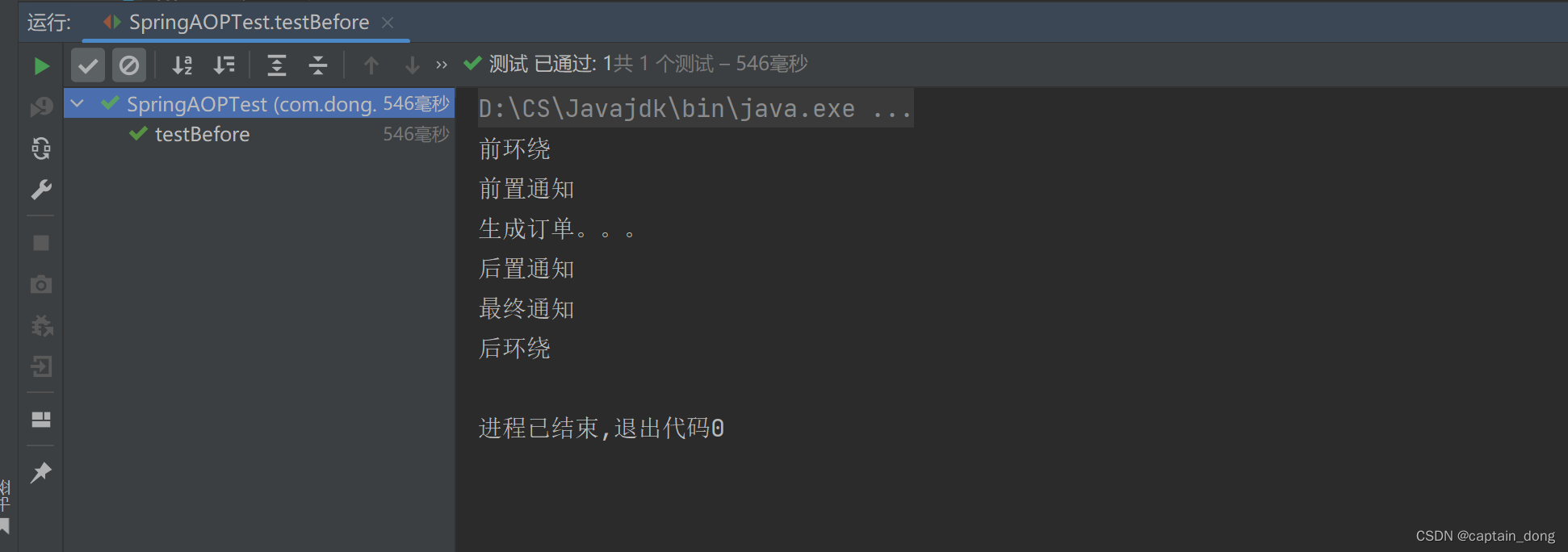
加上异常:
代码
package com.dong.service;
import org.springframework.stereotype.Service;
@Service("orderService")
public class OrderService { //目标类
//目标方法
public void generate(){
System.out.println("生成订单。。。");
if (1==1){
throw new RuntimeException(
"运行时异常"
);
}
}
}
//异常通知
@AfterThrowing("execution(* com.dong.service..*(..))")
public void afterThrowingAdvice(){
System.out.println("异常通知");
}运行结果

切面的先后顺序
我们知道,业务流程当中不一定只有一个切面,可能有的切面控制事务,有的记录日志,有的进行安全控制,如果多个切面的话,顺序如何控制:可以使用@Order注解来标识切面类,为@Order注解的value指定一个整数型的数字,数字越小,优先级越高。
再定义一个切面类,如下:
-
另一个切面类,并设置优先级
package com.dong.spring6.service;
import org.aspectj.lang.ProceedingJoinPoint;
import org.aspectj.lang.annotation.*;
import org.springframework.core.annotation.Order;
import org.springframework.stereotype.Component;
@Aspect
@Component
@Order(1) //设置优先级
public class YourAspect {
@Around("execution(* com.powernode.spring6.service.OrderService.*(..))")
public void aroundAdvice(ProceedingJoinPoint proceedingJoinPoint) throws Throwable {
System.out.println("YourAspect环绕通知开始");
// 执行目标方法。
proceedingJoinPoint.proceed();
System.out.println("YourAspect环绕通知结束");
}
@Before("execution(* com.powernode.spring6.service.OrderService.*(..))")
public void beforeAdvice(){
System.out.println("YourAspect前置通知");
}
@AfterReturning("execution(* com.powernode.spring6.service.OrderService.*(..))")
public void afterReturningAdvice(){
System.out.println("YourAspect后置通知");
}
@AfterThrowing("execution(* com.powernode.spring6.service.OrderService.*(..))")
public void afterThrowingAdvice(){
System.out.println("YourAspect异常通知");
}
@After("execution(* com.powernode.spring6.service.OrderService.*(..))")
public void afterAdvice(){
System.out.println("YourAspect最终通知");
}
}
-
设置切面类MyAspect的优先级
package com.dong.spring6.service;
import org.aspectj.lang.ProceedingJoinPoint;
import org.aspectj.lang.annotation.*;
import org.springframework.core.annotation.Order;
import org.springframework.stereotype.Component;
// 切面类
@Component
@Aspect
@Order(2) //设置优先级
public class MyAspect {
@Around("execution(* com.powernode.spring6.service.OrderService.*(..))")
public void aroundAdvice(ProceedingJoinPoint proceedingJoinPoint) throws Throwable {
System.out.println("环绕通知开始");
// 执行目标方法。
proceedingJoinPoint.proceed();
System.out.println("环绕通知结束");
}
@Before("execution(* com.powernode.spring6.service.OrderService.*(..))")
public void beforeAdvice(){
System.out.println("前置通知");
}
@AfterReturning("execution(* com.powernode.spring6.service.OrderService.*(..))")
public void afterReturningAdvice(){
System.out.println("后置通知");
}
@AfterThrowing("execution(* com.powernode.spring6.service.OrderService.*(..))")
public void afterThrowingAdvice(){
System.out.println("异常通知");
}
@After("execution(* com.powernode.spring6.service.OrderService.*(..))")
public void afterAdvice(){
System.out.println("最终通知");
}
}执行测试程序:
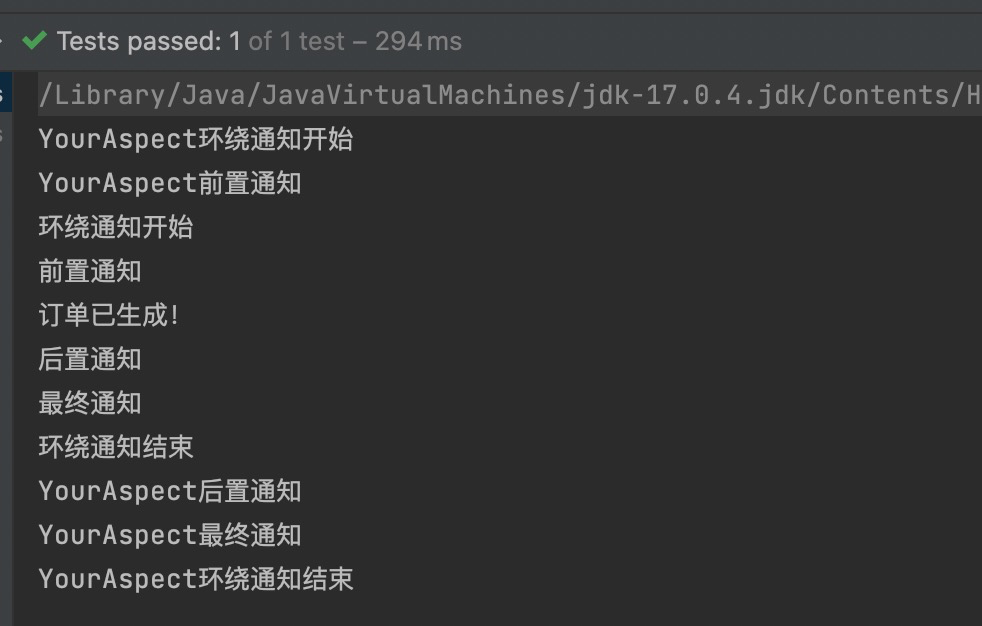
通过修改@Order注解的整数值来切换顺序,执行测试程序:
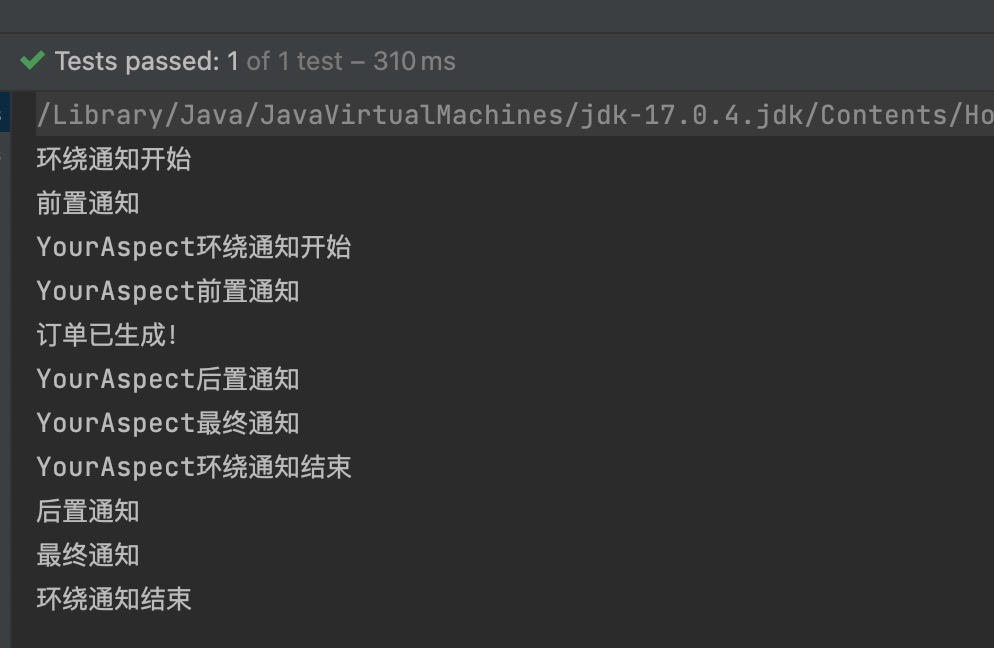
优化使用切点表达式

缺点是:
- 第一:切点表达式重复写了多次,没有得到复用。
- 第二:如果要修改切点表达式,需要修改多处,难维护。
可以这样做:将切点表达式单独的定义出来,在需要的位置引入即可。如下:
package com.dong.service;
import org.aspectj.lang.ProceedingJoinPoint;
import org.aspectj.lang.annotation.*;
import org.springframework.stereotype.Component;
@Component("logAspect")
@Aspect //切面类是需要使用@Aspect 注解进行标注的
public class LogAspect { //切面
//切面= 通知 + 切点
//通知就是增强,就是具体的要编写的增强代码
//这里通知Advice以方法的形式出现。(因为方法中可以写代码)
// @Before注解标注的方法就是一个前置通知
/* @Before("execution(* com.dong.service..*(..))")
public void 增强(){
System.out.println("这是一段增强代码。。。。。。");
}*/
//定义通用切点
@Pointcut("execution(* com.dong.service..*(..))")
public void 通用切点(){
//这个方法只是一个标记,方法名随意,方法体中也不需要写任何代码
}
@Before("通用切点()")
public void beforeAdvice(){
System.out.println("前置通知");
}
@AfterReturning("通用切点()")
public void afterReturningAdvice(){
System.out.println("后置通知");
}
//环绕通知(环绕是最大的通知,在前置通知之前,在后置通知之后)
@Around("通用切点()")
public void aroundAdvice(ProceedingJoinPoint joinPoint) throws Throwable {
//前面的代码
System.out.println("前环绕");
//执行目标
joinPoint.proceed(); //执行目标
//后面的代码
System.out.println("后环绕");
}
//异常通知
@AfterThrowing("通用切点()")
public void afterThrowingAdvice(){
System.out.println("异常通知");
}
//最终通知(Finally语句块中的通知)
@After("通用切点()")
public void afterAdvice(){
System.out.println("最终通知");
}
}
使用@Pointcut注解来定义独立的切点表达式。
注意这个@Pointcut注解标注的方法随意,只是起到一个能够让@Pointcut注解编写的位置。
执行测试程序:

小细节---Spring AOP基于注解之连接点
测试代码
@Before("通用切点()")
public void beforeAdvice(JoinPoint joinPoint){
System.out.println("前置通知");
//这个JoinPoint joinPoint,在Spring容器调用这个方法的时候自动传过来
//Signature signature = joinPoint.getSignature();获取目标方法的签名。
//通过方法的签名可以获取到一个方法的具体信息。
//获取目标方法的方法名
System.out.println("目标方法的方法名:"+joinPoint.getSignature().getName());
//获取目标方法的的方法修饰符
//获取目标方法的方法返回值
}运行结果

代码
@Before("通用切点()")
public void beforeAdvice(JoinPoint joinPoint){
System.out.println("前置通知");
//这个JoinPoint joinPoint,在Spring容器调用这个方法的时候自动传过来
//Signature signature = joinPoint.getSignature();获取目标方法的签名。
//通过方法的签名可以获取到一个方法的具体信息。
//获取目标方法的方法名
System.out.println("目标方法的方法名:"+joinPoint.getSignature().getName());
//获取目标方法的的方法修饰符
System.out.println("目标方法的的方法修饰符:"+joinPoint.getSignature().getModifiers());
//获取目标方法的方法返回值
System.out.println(joinPoint.getSignature());
System.out.println("目标方法的的全限定类名:"+joinPoint.getSignature().getDeclaringTypeName());
}运行结果

全注解式开发AOP
代码【编写一个类】
package com.dong.service;
import org.springframework.context.annotation.ComponentScan;
import org.springframework.context.annotation.Configuration;
import org.springframework.context.annotation.EnableAspectJAutoProxy;
@Configuration//代替spring.xml 文件
@ComponentScan({"com.dong.service"})
@EnableAspectJAutoProxy(proxyTargetClass = true)//启用aspect的自动代理
public class SpringConfig {
}
//全注解式开发
@Test
public void testNoXml(){
ApplicationContext applicationContext=new AnnotationConfigApplicationContext(SpringConfig.class);
OrderService orderService = applicationContext.getBean("orderService", OrderService.class);
orderService.generate();
}运行结果
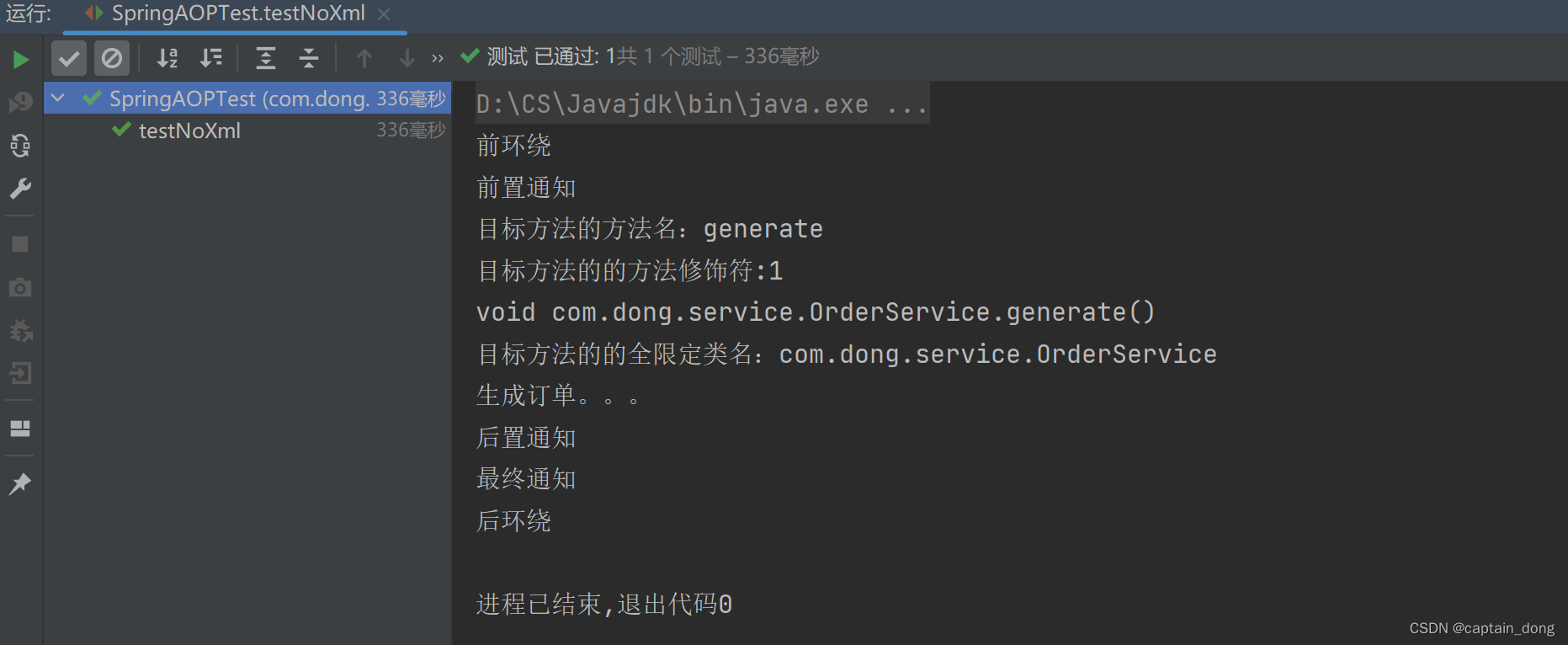
15.4.3 基于XML配置方式的AOP(了解)
15.5 AOP的实际案例:事务处理
项目中的事务控制是在所难免的。在一个业务流程当中,可能需要多条DML语句共同完成,为了保证数据的安全,这多条DML语句要么同时成功,要么同时失败。这就需要添加事务控制的代码。例如以下伪代码:
- 伪代码
class 业务类1{
public void 业务方法1(){
try{
// 开启事务
startTransaction();
// 执行核心业务逻辑
step1();
step2();
step3();
....
// 提交事务
commitTransaction();
}catch(Exception e){
// 回滚事务
rollbackTransaction();
}
}
public void 业务方法2(){
try{
// 开启事务
startTransaction();
// 执行核心业务逻辑
step1();
step2();
step3();
....
// 提交事务
commitTransaction();
}catch(Exception e){
// 回滚事务
rollbackTransaction();
}
}
public void 业务方法3(){
try{
// 开启事务
startTransaction();
// 执行核心业务逻辑
step1();
step2();
step3();
....
// 提交事务
commitTransaction();
}catch(Exception e){
// 回滚事务
rollbackTransaction();
}
}
}
class 业务类2{
public void 业务方法1(){
try{
// 开启事务
startTransaction();
// 执行核心业务逻辑
step1();
step2();
step3();
....
// 提交事务
commitTransaction();
}catch(Exception e){
// 回滚事务
rollbackTransaction();
}
}
public void 业务方法2(){
try{
// 开启事务
startTransaction();
// 执行核心业务逻辑
step1();
step2();
step3();
....
// 提交事务
commitTransaction();
}catch(Exception e){
// 回滚事务
rollbackTransaction();
}
}
public void 业务方法3(){
try{
// 开启事务
startTransaction();
// 执行核心业务逻辑
step1();
step2();
step3();
....
// 提交事务
commitTransaction();
}catch(Exception e){
// 回滚事务
rollbackTransaction();
}
}
}
//......可以看到,这些业务类中的每一个业务方法都是需要控制事务的,而控制事务的代码又是固定的格式,都是:
try{
// 开启事务
startTransaction();
// 执行核心业务逻辑
//......
// 提交事务
commitTransaction();
}catch(Exception e){
// 回滚事务
rollbackTransaction();
}这个控制事务的代码就是和业务逻辑没有关系的“交叉业务”。以上伪代码当中可以看到这些交叉业务的代码没有得到复用,并且如果这些交叉业务代码需要修改,那必然需要修改多处,难维护,怎么解决?
可以采用AOP思想解决。可以把以上控制事务的代码作为环绕通知,切入到目标类的方法当中。接下来我们做一下这件事,有两个业务类,如下:
代码
spring.xml
<?xml version="1.0" encoding="UTF-8"?>
<beans xmlns="http://www.springframework.org/schema/beans"
xmlns:xsi="http://www.w3.org/2001/XMLSchema-instance"
xmlns:context="http://www.springframework.org/schema/context"
xmlns:aop="http://www.springframework.org/schema/aop"
xsi:schemaLocation="http://www.springframework.org/schema/beans http://www.springframework.org/schema/beans/spring-beans.xsd
http://www.springframework.org/schema/context http://www.springframework.org/schema/context/spring-context.xsd
http://www.springframework.org/schema/aop http://www.springframework.org/schema/aop/spring-aop.xsd">
<!--组件扫描-->
<context:component-scan base-package="com.dong.spring6.service"/>
<!--启动自动代理-->
<aop:aspectj-autoproxy/>
</beans>银行账户的业务类
package com.dong.spring6.service;
import org.springframework.stereotype.Service;
@Service
public class AccountService { //目标对象
//目标方法
//转账的业务方法
public void transfer(){
System.out.println("银行账户正在完成转账操作....");
}
//目标方法
//取款的业务方法
public void withdraw(){
System.out.println("正在取款,请稍后......");
}
}
订单业务类
package com.dong.spring6.service;
import org.springframework.stereotype.Service;
@Service
public class OrderService { //目标对象
//目标方法
//生成订单的业务方法
public void generate(){
System.out.println("正在生成订单.....");
}
//目标方法
//订单取消的业务方法
public void cancel(){
System.out.println("订单取消...");
}
}
注意,以上两个业务类已经纳入spring bean的管理,因为都添加了@Component注解。
接下来我们给以上两个业务类的4个方法添加事务控制代码,使用AOP来完成:
事务切面类
package com.dong.spring6.service;
import org.aspectj.lang.ProceedingJoinPoint;
import org.aspectj.lang.annotation.Around;
import org.aspectj.lang.annotation.Aspect;
import org.springframework.stereotype.Component;
/**
* 切面
*/
@Component
@Aspect
public class TransactionAspect {
@Around("execution(* com.dong.spring6.service..*(..))")
public void aroundAdvice(ProceedingJoinPoint joinPoint){
//执行目标
try {
//前环绕
System.out.println("开启事务.....");
//执行目标
joinPoint.proceed();
//后环绕
System.out.println("提交事务.....");
} catch (Throwable e) {
System.out.println("回滚事务");
}
}
}
上述事务控制代码只需要写一次就行了,并且修改起来也没有成本。
编写测试程序:
package com.dong.spring6.test;
import com.dong.spring6.service.AccountService;
import com.dong.spring6.service.OrderService;
import org.junit.Test;
import org.springframework.context.ApplicationContext;
import org.springframework.context.annotation.AnnotationConfigApplicationContext;
import org.springframework.context.support.ClassPathXmlApplicationContext;
public class AOPRealAppTest {
//编程式事务解决方案。
@Test
public void testTransaction(){
ApplicationContext applicationContext=new ClassPathXmlApplicationContext("spring.xml");
AccountService accountService = applicationContext.getBean("accountService", AccountService.class);
OrderService orderService = applicationContext.getBean("orderService", OrderService.class);
accountService.transfer();
accountService.withdraw();
orderService.generate();
orderService.cancel();
}
}
运行结果

有异常时:
增添代码:
package com.dong.spring6.service;
import org.springframework.stereotype.Service;
@Service
public class OrderService { //目标对象
//目标方法
//生成订单的业务方法
public void generate(){
System.out.println("正在生成订单.....");
}
//目标方法
//订单取消的业务方法
public void cancel(){
System.out.println("订单取消...");
//空指针异常
String s=null;
s.toString();
}
}
运行结果

15.6 AOP的实际案例:安全日志
需求是这样的:项目开发结束了,已经上线了。运行正常。客户提出了新的需求:凡事在系统中进行修改操作的,删除操作的,新增操作的,都要把这个人记录下来。因为这几个操作是属于危险行为。例如有业务类和业务方法:
spring.xml
<?xml version="1.0" encoding="UTF-8"?>
<beans xmlns="http://www.springframework.org/schema/beans"
xmlns:xsi="http://www.w3.org/2001/XMLSchema-instance"
xmlns:context="http://www.springframework.org/schema/context"
xmlns:aop="http://www.springframework.org/schema/aop"
xsi:schemaLocation="http://www.springframework.org/schema/beans http://www.springframework.org/schema/beans/spring-beans.xsd
http://www.springframework.org/schema/context http://www.springframework.org/schema/context/spring-context.xsd
http://www.springframework.org/schema/aop http://www.springframework.org/schema/aop/spring-aop.xsd">
<!--组件扫描-->
<context:component-scan base-package="com.dong.spring6"/>
<!--启动自动代理-->
<aop:aspectj-autoproxy/>
</beans>用户业务类
package com.dong.spring6.biz;
import org.springframework.stereotype.Service;
@Service
public class UserService {
public void saveUser(){
System.out.println("新增用户信息");
}
public void deleteUser(){
System.out.println("删除用户信息");
}
public void modifyUser(){
System.out.println("修改用户信息");
}
public void getUser(){
System.out.println("获取用户信息");
}
}
VIP业务类
package com.dong.spring6.biz;
import org.springframework.stereotype.Service;
@Service
public class VipService {
public void saveVip(){
System.out.println("新增会员信息");
}
public void deleteVip(){
System.out.println("删除会员信息");
}
public void modifyVip(){
System.out.println("修改会员信息");
}
public void getVip(){
System.out.println("获取会员信息");
}
}
注意:已经添加了@Servic ( @Component )注解。
接下来我们使用aop来解决上面的需求:
编写一个负责安全的切面类
package com.dong.spring6.biz;
import org.aspectj.lang.JoinPoint;
import org.aspectj.lang.annotation.Aspect;
import org.aspectj.lang.annotation.Before;
import org.aspectj.lang.annotation.Pointcut;
import org.springframework.stereotype.Component;
import java.text.SimpleDateFormat;
import java.util.Date;
@Component
@Aspect
public class SecurityLogAspect {
@Pointcut("execution(* com.dong.spring6.biz..save*(..))")
public void savePointCut(){
}
@Pointcut("execution(* com.dong.spring6.biz..delete*(..))")
public void deletePointCut(){
}
@Pointcut("execution(* com.dong.spring6.biz..modify*(..))")
public void modifyPointCut(){
}
@Pointcut("execution(* com.dong.spring6.biz..get*(..))")
public void getPointCut(){
}
@Before("savePointCut()||deletePointCut()||modifyPointCut()")
public void beforeAdvice(JoinPoint joinPoint){
SimpleDateFormat simpleDateFormat=new SimpleDateFormat("yyyy-MM-dd HH:mm:ss SSS");
String nowTime = simpleDateFormat.format(new Date());
//输出日志信息
System.out.println(nowTime+" zhangsan"+joinPoint.getSignature().getDeclaringTypeName()+"."+joinPoint.getSignature().getName());
}
}
测试程序
@Test
public void testSecurityLog(){
ApplicationContext applicationContext=new ClassPathXmlApplicationContext("spring.xml");
UserService userService = applicationContext.getBean("userService", UserService.class);
VipService vipService = applicationContext.getBean("vipService", VipService.class);
userService.saveUser();
userService.deleteUser();
userService.modifyUser();
userService.getUser();
vipService.saveVip();
vipService.deleteVip();
vipService.modifyVip();
vipService.getVip();
}运行结果

十六、Spring对事务的支持
16.1 事务概述
- 什么是事务
-
- 在一个业务流程当中,通常需要多条DML(insert delete update)语句共同联合才能完成,这多条DML语句必须同时成功,或者同时失败,这样才能保证数据的安全。
- 多条DML要么同时成功,要么同时失败,这叫做事务。
- 事务:Transaction(tx)
- 事务的四个处理过程:
-
- 第一步:开启事务 (start transaction)
- 第二步:执行核心业务代码
- 第三步:提交事务(如果核心业务处理过程中没有出现异常)(commit transaction)
- 第四步:回滚事务(如果核心业务处理过程中出现异常)(rollback transaction)
- 事务的四个特性:
-
- A 原子性:事务是最小的工作单元,不可再分。
- C 一致性:事务要求要么同时成功,要么同时失败。事务前和事务后的总量不变。
- I 隔离性:事务和事务之间因为有隔离性,才可以保证互不干扰。
- D 持久性:持久性是事务结束的标志。
16.2 引入事务场景
以银行账户转账为例学习事务。两个账户act-001和act-002。act-001账户向act-002账户转账10000,必须同时成功,或者同时失败。(一个减成功,一个加成功, 这两条update语句必须同时成功,或同时失败。)
连接数据库的技术采用Spring框架的JdbcTemplate。
采用三层架构搭建:
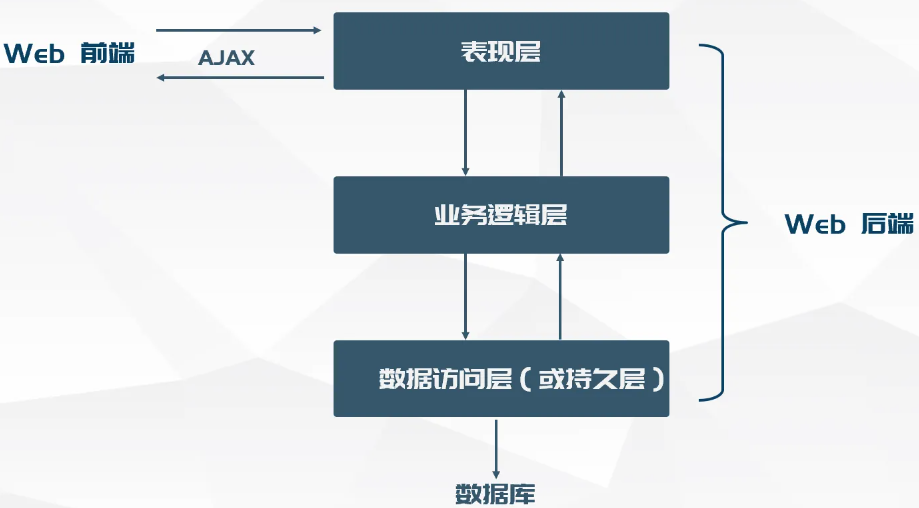
模块名:spring6-013-tx-bank(依赖如下)
pom.xml
<?xml version="1.0" encoding="UTF-8"?>
<project xmlns="http://maven.apache.org/POM/4.0.0"
xmlns:xsi="http://www.w3.org/2001/XMLSchema-instance"
xsi:schemaLocation="http://maven.apache.org/POM/4.0.0 http://maven.apache.org/xsd/maven-4.0.0.xsd">
<modelVersion>4.0.0</modelVersion>
<groupId>com.dong</groupId>
<artifactId>spring6-013-tx-bank</artifactId>
<version>1.0-SNAPSHOT</version>
<packaging>jar</packaging>
<!--依赖-->
<dependencies>
<!--spring context依赖-->
<dependency>
<groupId>org.springframework</groupId>
<artifactId>spring-context</artifactId>
<version>6.0.11</version>
</dependency>
<!--spring aspects依赖-->
<dependency>
<groupId>org.springframework</groupId>
<artifactId>spring-aspects</artifactId>
<version>6.0.11</version>
</dependency>
<!--junit依赖-->
<dependency>
<groupId>junit</groupId>
<artifactId>junit</artifactId>
<version>4.13.2</version>
<scope>test</scope>
</dependency>
<!--spring jdbc-->
<dependency>
<groupId>org.springframework</groupId>
<artifactId>spring-jdbc</artifactId>
<version>6.0.11</version>
</dependency>
<!--mysql驱动-->
<dependency>
<groupId>mysql</groupId>
<artifactId>mysql-connector-java</artifactId>
<version>8.0.33</version>
</dependency>
<!--德鲁伊连接池-->
<dependency>
<groupId>com.alibaba</groupId>
<artifactId>druid</artifactId>
<version>1.2.16</version>
</dependency>
<!--@Resource注解-->
<dependency>
<groupId>jakarta.annotation</groupId>
<artifactId>jakarta.annotation-api</artifactId>
<version>2.1.1</version>
</dependency>
</dependencies>
<properties>
<maven.compiler.source>19</maven.compiler.source>
<maven.compiler.target>19</maven.compiler.target>
<project.build.sourceEncoding>UTF-8</project.build.sourceEncoding>
</properties>
</project>第一步:准备数据库表
表结构

表数据

第二步:创建包结构
com.dong.bank.pojo
com.dong.bank.service
com.dong.bank.service.impl
com.dong.bank.dao
com.dong.bank.dao.impl
第三步:准备POJO类
package com.dong.bank.pojo;
public class Account {
private String actno;
private double balance;
@Override
public String toString() {
return "Account{" +
"actno='" + actno + '\'' +
", balance=" + balance +
'}';
}
public Account() {
}
public Account(String actno, double balance) {
this.actno = actno;
this.balance = balance;
}
public String getActno() {
return actno;
}
public void setActno(String actno) {
this.actno = actno;
}
public double getBalance() {
return balance;
}
public void setBalance(double balance) {
this.balance = balance;
}
}
第四步:编写持久层
package com.dong.bank.dao;
import com.dong.bank.pojo.Account;
public interface AccountDao {
/**
* 根据账号查询账户信息
* @param actno
* @return
*/
Account selectByActNo(String actno);
/**
* 更新账户信息
* @param account
* @return
*/
int update(Account account);
}
package com.dong.bank.dao.impl;
import com.dong.bank.dao.AccountDao;
import com.dong.bank.pojo.Account;
import jakarta.annotation.Resource;
import org.springframework.jdbc.core.BeanPropertyRowMapper;
import org.springframework.jdbc.core.JdbcTemplate;
import org.springframework.stereotype.Repository;
@Repository("accountDao")
public class AccountDaoImpl implements AccountDao {
@Resource(name = "jdbcTemplate")
private JdbcTemplate jdbcTemplate;
@Override
public Account selectByActNo(String actno) {
String sql="select actno, balance from t_act where actno=?";
Account account = jdbcTemplate.queryForObject(sql, new BeanPropertyRowMapper<>(Account.class), actno);
return account;
}
@Override
public int update(Account account) {
String sql="update t_act set balance=? where actno=?";
int count = jdbcTemplate.update(sql, account.getBalance(), account.getActno());
return count;
}
}
第五步:编写业务层
package com.dong.bank.service;
/**
* 业务接口
* 事务就是在这个接口下控制的
*/
public interface AccountService {
/**
* 转账业务方法
* @param fromActno 从这个账户转出
* @param toActno 转入这个账户
* @param money 转账金额
*/
void transfer(String fromActno,String toActno,double money);
}
package com.dong.bank.service.impl;
import com.dong.bank.dao.AccountDao;
import com.dong.bank.pojo.Account;
import com.dong.bank.service.AccountService;
import jakarta.annotation.Resource;
import org.springframework.stereotype.Service;
@Service("accountService")
public class AccountServiceImpl implements AccountService {
@Resource(name = "accountDao")
private AccountDao accountDao;
//控制事务,因为在这个方法中要完成所有的转账业务
@Override
public void transfer(String fromActno, String toActno, double money) {
//查询转出账户的余额是否充足
Account fromAct = accountDao.selectByActNo(fromActno);
if (fromAct.getBalance()<money){
throw new RuntimeException("余额不足!!!");
}
//余额充足
Account toAct = accountDao.selectByActNo(toActno);
//将内存中的两个对象的余额先修改
fromAct.setBalance(fromAct.getBalance()-money);
toAct.setBalance(fromAct.getBalance()+money);
//数据库更新
int count = accountDao.update(fromAct);
count+=accountDao.update(toAct);
if (count!=2){
throw new RuntimeException("转账失败,请联系银行!!!");
}
}
}
第六步:编写Spring配置文件
<?xml version="1.0" encoding="UTF-8"?>
<beans xmlns="http://www.springframework.org/schema/beans"
xmlns:xsi="http://www.w3.org/2001/XMLSchema-instance"
xmlns:context="http://www.springframework.org/schema/context"
xsi:schemaLocation="http://www.springframework.org/schema/beans http://www.springframework.org/schema/beans/spring-beans.xsd
http://www.springframework.org/schema/context http://www.springframework.org/schema/context/spring-context.xsd">
<!--组件扫描-->
<context:component-scan base-package="com.dong.bank"/>
<!--配置数据源-->
<bean id="dataSource" class="com.alibaba.druid.pool.DruidDataSource">
<property name="driverClassName" value="com.mysql.cj.jdbc.Driver"/>
<property name="url" value="jdbc:mysql://localhost:3306/spring6"/>
<property name="username" value="root"/>
<property name="password" value="15088143946Sld"/>
</bean>
<!--配置jdbcTemplate-->
<bean id="jdbcTemplate" class="org.springframework.jdbc.core.JdbcTemplate">
<property name="dataSource" ref="dataSource"/>
</bean>
</beans>
第七步:编写表示层(测试程序)
代码
package com.dong.bank.test;
import com.dong.bank.service.AccountService;
import org.junit.Test;
import org.springframework.context.ApplicationContext;
import org.springframework.context.support.ClassPathXmlApplicationContext;
public class SpringTxTest {
@Test
public void testSpringTx(){
ApplicationContext applicationContext=new ClassPathXmlApplicationContext("spring.xml");
AccountService accountService = applicationContext.getBean("accountService", AccountService.class);
try {
accountService.transfer("act-001", "act-002", 10000);
System.out.println("转账成功。");
}catch (Exception e){
e.printStackTrace();
System.out.println("转账失败。");
}
}
}
执行结果:

数据变化:

模拟异常
package com.dong.bank.service.impl;
import com.dong.bank.dao.AccountDao;
import com.dong.bank.pojo.Account;
import com.dong.bank.service.AccountService;
import jakarta.annotation.Resource;
import org.springframework.stereotype.Service;
@Service("accountService")
public class AccountServiceImpl implements AccountService {
@Resource(name = "accountDao")
private AccountDao accountDao;
//控制事务,因为在这个方法中要完成所有的转账业务
@Override
public void transfer(String fromActno, String toActno, double money) {
//第一步:开启事务
//第二步:执行核心业务逻辑
//查询转出账户的余额是否充足
Account fromAct = accountDao.selectByActNo(fromActno);
if (fromAct.getBalance()<money){
throw new RuntimeException("余额不足!!!");
}
//余额充足
Account toAct = accountDao.selectByActNo(toActno);
//将内存中的两个对象的余额先修改
fromAct.setBalance(fromAct.getBalance()-money);
toAct.setBalance(fromAct.getBalance()+money);
//数据库更新
int count = accountDao.update(fromAct);
count+=accountDao.update(toAct);
//模拟异常
String s=null;
s.toString();
if (count!=2){
throw new RuntimeException("转账失败,请联系银行!!!");
}
//第三步:如果执行业务流程过程中,没有异常。提交事务
//第四步:如果执行业务流程过程中,有异常,回滚事务
}
}
执行结果:

数据库表中数据:
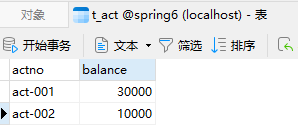
- 转出成功,但是转入失败! 不同步更新!
丢了1万!!!
16.3 Spring对事务的支持
Spring实现事务的两种方式
-
编程式事务
-
- 通过编写代码的方式来实现事务的管理。
-
声明式事务
-
- 基于注解方式
- 基于XML配置方式
Spring事务管理API
Spring对事务的管理底层实现方式是基于AOP实现的。采用AOP的方式进行了封装。所以Spring专门针对事务开发了一套API,API的核心接口如下:
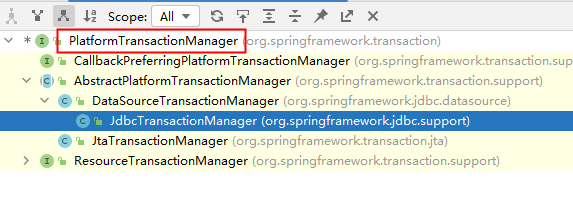
PlatformTransactionManager接口:spring事务管理器的核心接口。在Spring6中它有两个实现:
- DataSourceTransactionManager:支持JdbcTemplate、MyBatis、Hibernate等事务管理。
- JtaTransactionManager:支持分布式事务管理。
如果要在Spring6中使用JdbcTemplate,就要使用DataSourceTransactionManager来管理事务。(Spring内置写好了,可以直接用。)
声明式事务之注解实现方式
- 第一步:在spring配置文件中配置事务管理器。
- 第二步:在spring配置文件中引入tx命名空间。
- 第三步:在spring配置文件中配置“事务注解驱动器”,开始注解的方式控制事务。
- 第四步:在service类上或方法上添加@Transactional注解
在类上添加该注解,该类中所有的方法都有事务。在某个方法上添加该注解,表示只有这个方法使用事务。





